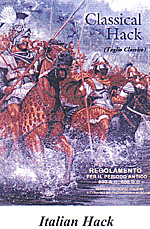"Italian Hack"
A Brief History of Classical Hack Overseas
by Luca Marini
| |
Well, after all that time, Classical Hack was the answer! After I found it in the net, I wrote to Phil for some questions (the first one that any seasoned gamer, owner of thousands of based miniatures, does: "how large the bases are?"). Phil, as he always proved to be thereafter, was extremely rapid in his answer and after some days, I got Classical Hack in my hands (it was a torrid August, I remember, and in our first reading we were lying on the beach). At the first games there were some question to be resolved but the system proved immediately to be easy to play and very "historical". That was exactly what we were looking for! After some exchanges in e-mail, Phil proposed to us to translate the rule set in Italian and we were really happy for that: that work could have contribute to promote Classical Hack in our country (a lot of Italian wargamers can read English but everyone is more happy to have a rule set in its own mother tongue...). So we start to translate the rules, including all the errata and clarifications we discussed by e-mail with Phil: and, more, we added some home rules we had choice to apply to improve the rules (by our point of view, obviously) and some army lists about ancient Italian peoples (Samnite, Etruscans, & Syracusan): last but not least, we add some pages to our web site as the "official Italian site of Classical Hack" (! ! ! ). There you can find the army lists and some rule variants (http://www.geocities.com/TimesSquare/Labyrinth/3089/CH/italpeop.htm). In my opinion, Classical Hack's greatest point is its basic system: it's simple but it works! It has a strong base that allows you to play as it is or, if you prefer, to change some rules as you like, maintaining the general skeleton and the rules still works! The even better thing is Phil's philosophy: "if you do not like that rule, change it!". Well, we prepared the translation and we published it in a quite good form (I deem). We presented it at some wargame conventions with historical scenarios: Pidna, Magnesia and Alesia, with a section of the Roman system of fortification, which we presented also at the World Model Expo in Rome, hold in 2002 (you can see some images in our site, at: http://www.geocities.com/TimesSquare/Labyrinth/3089/alesia/Lefoto.htm). I sent a copy of our work to Phil and one evening I was extremely excited by an overseas telephone call: it was Phil in person that wanted to congratulate me for the result! It was a really great emotion! Since then we followed the development of the rules up to the last edition, but here we adopted some really great differences from the original second edition, maintaining some of the old edition (i.e., the percentage dices) mixing with some of the new rules and adding our own home rules. So, we developed a true different form of Classical Hack, that is "Italian Hack", with the original flavour and a "Roman" touch! Back to Table of Contents -- Classical Hack Newsletter # 9 Back to Classical Hack Newsletter List of Issues Back to MagWeb Master Magazine List © Copyright 2005 by Phil Viverito. This article appears in MagWeb.com (Magazine Web) on the Internet World Wide Web. Other articles from military history and related magazines are available at http://www.magweb.com |
 A typical character of the Roman armies was the ability in understanding the best tactics and weapons used by their enemies, adopting them and adapting to their human and social environment: such was the destiny of the gladius, suggested by the Iberian people, and of the large shield, up to the clibanarii, adopted by the deadly eastern cavalries, such as Parthians and Sassanids. Well, that is exactly what happened, in 1997, when a wargamer group from Rome put the hands on a copy of Classical Hack! I am an old wargamer - my first game was in the far 1976, I deem - but at the end of the ninety my group was still searching his "true" ancient set rule. We tested anything, from WRG editions to Tactica and for a long season we were deeply involved with ARMATI: very good sets, but something different from what we were searching. The one that we feel was to be, at the same time, fun enough to be played and so "historical" not to be confused with a tournament game.
A typical character of the Roman armies was the ability in understanding the best tactics and weapons used by their enemies, adopting them and adapting to their human and social environment: such was the destiny of the gladius, suggested by the Iberian people, and of the large shield, up to the clibanarii, adopted by the deadly eastern cavalries, such as Parthians and Sassanids. Well, that is exactly what happened, in 1997, when a wargamer group from Rome put the hands on a copy of Classical Hack! I am an old wargamer - my first game was in the far 1976, I deem - but at the end of the ninety my group was still searching his "true" ancient set rule. We tested anything, from WRG editions to Tactica and for a long season we were deeply involved with ARMATI: very good sets, but something different from what we were searching. The one that we feel was to be, at the same time, fun enough to be played and so "historical" not to be confused with a tournament game.